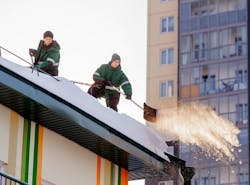Prepare Your Building for Winter Now
Buildings in some locations might only need to focus on HVAC and IAQ, while others need to get ready inside and out.
“Make sure you add snow removal to your annual budget because it’s a big expense.” - Brad Caton
Below are tips on common areas to look at and winterize now.
Healthy HVAC Tips
Because the HVAC system affects your entire building, it’s important it’s tuned up and ready for winter weather.
Joe Marian, Jr., service manager at ABM Industries, acknowledges each facility type and actual building is different, but there are common actions to prepare for winter weather:
- Have a full inspection of the HVAC equipment before winter by a qualified service technician.
- Uncover opportunities for energy savings. Set space thermostats to lower set points. Shut down unnecessary cooling equipment and systems.
- Close off main water and drain water piping in unheated spaces.
- Drain and winterize cooling towers, if not in use.
- Be aware of IAQ. Find out how not to let sick building syndrome reduce productivity in your facility.
- Inspect roofs, weather stripping and insulation for holes or leaks and repair to prevent energy loss.
- Ensure the building envelope doesn’t have significant air leaks or areas of infiltration.
Except for the HVAC equipment inspection and anything involving code or equipment manufacturer requirements, much of this can be done in-house. “The on-site staff knows their facility better than anyone,” Marian says. “And in most cases, the winterization process is a matter of common sense and proper housekeeping.”
Think of winter preparation as insurance on the equipment. Kevin Miskewicz, director of commercial product planning at Mitsubishi Electric, says that “properly protecting your HVAC system from extreme weather conditions can improve its performance and lifespan. Investing in snow hoods, wind baffles and outdoor unit stands prevents snow and ice from getting inside the equipment and potentially causing damage.”
Winterizing Angles
Marian suggests looking at winterizing from three angles:
1. Energy Savings: Think about how each space within a building is used. “Let’s say the facility has a conference room that’s used once a week for an hourlong meeting, a gym, a warehouse and a shared office space that’s occupied 40 hours a week,” Miskewicz says.
“All of these spaces have different cooling and heating needs. The conference room, for example, doesn’t need to be constantly heated if it’s unoccupied. The way the facility manager approaches the needs of the different spaces has a big impact on occupant comfort and the facility’s utility bills.”
2. Occupant Comfort: Making sure tenants and visitors are comfortable is important. Being in the building when the heat turns on for the first time can be unpleasant.
3. Disaster Prevention: Prevent frozen and bursting water pipes. “Any one of these water systems freezing up can cause catastrophic equipment failures, infrastructure damage from water leaks or life safety issues,” Marian explains.
Inspect Roof Now and Throughout Winter
In “Win the Winter Roofing War”, Adam Herring, senior project manager at Highland Commercial Roofing, says that “some building owners perform these in-house, but if you plan to hire someone else to do the inspection, take into consideration that there could be long lead times as you get closer to winter and plan accordingly.”
He also suggests looking for roof damage caused by birds, especially around HVAC equipment or places that water collects. The inspection is an opportunity to remove debris and organic material that may have collected.
Throughout the winter, Herring encourages periodic checks of how the roof looks, and make sure nothing is wrong or building up (e.g. icicles at the gutter, which could indicate an ice dam, or a pile of snow blocking an access ladder).
Knowing all you can about your roof (e.g. what to do if something happens, proper care and maintenance) will help make winter upkeep and safety easier.
Smooth Snow Removal Solutions
If not properly removed and maintained, snow can cause underlying problems.
For example, ice can build up when snow or rain freezes, increasing the chances for slip-and-fall accidents. Another consideration from not properly removing snow includes obstruction of things like fire hydrants, signs and handicap parking spaces.
Brad Caton, founder and CEO of Invictus Professional Snowfighters Ltd., suggests that facility managers be prepared and have a plan before first snow. This includes:
- Testing snow removal equipment is working properly
- Reach out to snow removal team to make sure everyone is prepared and under the same plan
- Having pavement anti-iced so it’s prepped for winter weather
The cost and time associated with snow removal are often forgotten, Caton warns. “Make sure you add snow removal to your annual budget because it’s a big expense.”
Also, “property managers should consider storing their snow removal equipment on site so that a driver can go directly there and get to work, instead of towing heavy and dangerous equipment with them,” he suggests.
If contracting out, property and facilities managers should look for snow and ice management companies that are certified and trained. Once a company is chosen, have the contractor come to your facility to do a site inspection before it snows to identify hazards and determine where the snow will go, Caton says.
Prepare In and Around Lobbies
The high-traffic entryway of lobbies shouldn’t be overlooked in winter preparation and floors need special attention.
Things used to keep pavement safe – like sand, grit and salt – get dragged in, and act like a sandpaper on the flooring that’s difficult to clean, warns Jeff Cross, consultant and trainer, and instructor with the Institute of Inspection, Cleaning and Restoration Certification (IICRC).
“Many maintenance workers will use the same cleaning process during winter that they use in warmer months, and that’s a big mistake,” he cautions. “Frequency of vacuuming must increase in the winter. So should dry soil removal and thorough cleaning of hard surfaces.”
Bob Clarke, senior vice president of sales and marketing at ABM, suggests some no- and low-cost ways to prepare the lobby for winter:
- Utilize safety mats and rugs: “This is one of the most critical strategies in a commercial property to prepare for winter,” he notes. “Matting best practices dictate there should be 5 to 10 feet of coarse matting outside a building, 5 to 10 feet of matting directly inside the building and another 5 to 10 feet of matting directly behind it.”
- Signage: Direct people to where you want them to go with signs and indicators.
- Day porters/day matrons: Consider adding or changing their schedule to be available in the lobby during bad weather.
- Schedule deeper cleans: Schedule your heavy-duty floor work around the inclement weather season: just before to protect and just after to correct. Typically, many of these costs are built into a housekeeping program.
- Put out hand sanitizer: Remember the one about protecting the environment: Strategically, but adequately placed hand sanitizer goes a long way in protecting your occupants and the environment.
- Look beyond the lobby: You need to focus on and protect all access points that are exposed to inclement weather.
WET Kit (Weather Event Tools)
Anthony Maione, president and CEO of Core Management Services, recommends keeping a WET (Weather Event Tools) kit ready. This includes a broom, mop-bucket-wringer, “Wet Floor” cone, shovel and some ice melt for immediate exteriors.
“Even the most effective plan to prevent the outdoors from being carried indoors will result in some tracking,” he says. “Prepare and keep handy a WET kit to address the water, snow, ice, salt or sand that evades preventative measures.”
“Many maintenance workers will use the same cleaning process during winter that they use in warmer months, and that’s a big mistake,” Jeff Cross cautions. “Frequency of vacuuming must increase in the winter. So should dry soil removal and thorough cleaning of hard surfaces.”
If it’s already too late for this year, be more prepared next year. Consider segmenting the year into scheduling blocks, Maione explains, noting that he sees people reallocate resources from the easier-to-clean summer months to the winter.
“A winter plan for next year begins immediately following this year’s winter season,” Maione says. “The lobby cleaning team evaluates the previous winter’s plan and its execution – its successes and shortcomings – and looks for opportunities to improve for next year.”
Two handpicked articles to read next:
About the Author

Valerie Dennis Craven
Content strategist and writer
Valerie Dennis Craven is an experienced writer of commercial and residential buildings and interiors, having previously served as Editorial Director for both BUILDINGS and i+s. Valerie enjoys writing about technology and how it impacts users in the built environment.
